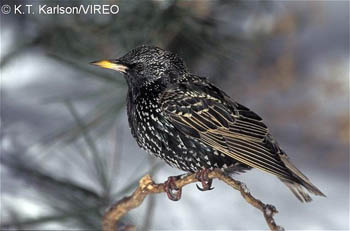Loading ...
European Starling
The European Starling (Sturnus vulgaris) is a chunky, black bird with a prominent yellow bill (in breeding season). Its short square tail and pointed wings give the bird a triangular profile in flight. As it walks on the ground, the starling has a characteristic waddling gait. The European Starling experience in the New World is the archetype of an alien species becoming invasive. Introduced in New York City in 1890, the European Starling invaded both cities and farmlands throughout North America, and the starling population is now estimated at more than 200 million birds. The species has also spread to parts of Mexico and the Bahamas. Flocks of thousands of birds migrate seasonally in the eastern and mid-west U.S, forming huge communal roosts in winter from which to make daily forays to plowed fields and lawns. The European Starling is a proficient mimic of bird, animal and human sounds, which it blends into a cacophony of whistles, warbles, clicks and clucks.
See all European Starling photosField Marks:
The European Starling has pointed, triangular wings, a disproportionately short, square tail, and in spring and early summer, glossy black plumage with purple-green iridescence. The late summer molt produces extensive white flecking on the tips of the feathers that wears off during the winter, as the initially dark bill lightens to yellow. (L. 8.5 in.).
Distribution:
The European Starling is a permanent resident throughout most of North America and part of northwest Mexico. Individuals migrate within the year-round range and a few go as far south as the Yucatan Peninsula.
Similar Species:
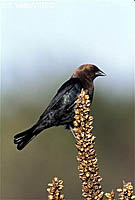 |
Brown-headed Cowbird (all photos) The native North American blackbirds all have longer tails and lack the Starling's pointed wings, triangular flight profile, and yellow bill. The Brown-headed Cowbird has a dark, conical bill and brown head contrasting with the black body. |
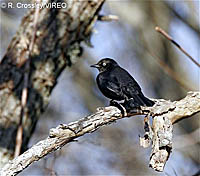
|
Rusty Blackbird (all photos) The Rusty Blackbird has a bright yellow eye. |
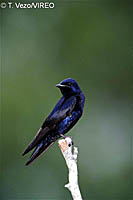 |
Purple Martin (all photos) The Purple Martin has the more svelte overall appearance of the swallow family, with longer wings and short dark bill. |
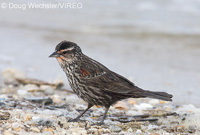
|
Red-winged blackbird (all photos-female) The female Red-winged Blackbird is somewhat similar to the European Starling in its non-breeding plumage. However, the non-breeding Starling is mainly white-spotted on greenish-black feathers, whereas the female Red-winged Blackbird has tan streaks on a brown body with rufous highlights. |
Habitat & Nesting:
The European Starling nests in all conceivable types of man-made and natural cavities. It aggressively evicts woodpeckers and other cavity-nesting birds. The only major habitats free of Starling invasion are dense forests and dry desert and chaparral.
More Information:
Starling control programs using detergents and noise seem to have achieved only limited, local success. Natural predators, like hawks, are often foiled by the Starlings' tactic of forming very compact aerial flocks and outmaneuvering or mobbing the larger birds.

